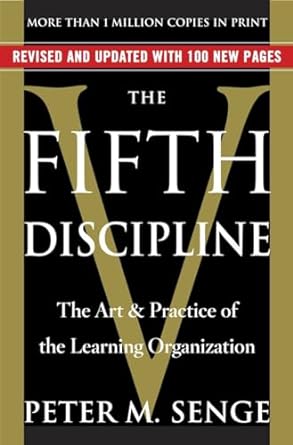The Fifth Discipline: A Comprehensive Exploration
Introduction
Peter Senge's The Fifth Discipline is a seminal work that introduced the concept of learning organizations. This comprehensive white paper will delve deeper into the five disciplines outlined in the book, exploring their implications for individuals, teams, and organizations.
The Five Disciplines
- Systems Thinking:
- Understanding Interconnectedness: Systems thinking is the cornerstone of a learning organization. It involves recognizing the interconnectedness of elements within a system and understanding how changes in one part can impact the whole.
- Identifying Leverage Points: By identifying leverage points, organizations can make significant changes with minimal effort.
- Shifting from Linear to Systems Thinking: This involves moving away from a cause-and-effect mindset to a more holistic, circular perspective.
- Personal Mastery:
- Continuous Learning: Individuals must commit to lifelong learning and personal growth.
- Clarifying Personal Vision: A clear personal vision provides direction and motivation.
- Developing Patience: Patience is essential for achieving long-term goals.
- Mental Models:
- Challenging Assumptions: Recognizing and questioning our mental models is crucial for innovation and change.
- Developing Reflective Thinking: By reflecting on our thoughts and actions, we can identify and eliminate limiting beliefs.
- Encouraging Open Dialogue: Open and honest communication is essential for surfacing and challenging mental models.
- Shared Vision:
- Building a Common Purpose: A shared vision unites individuals and teams towards a common goal.
- Inspiring Commitment: Leaders must inspire and motivate others to contribute to the shared vision.
- Creating a Sense of Belonging: A strong sense of belonging fosters collaboration and innovation.
- Team Learning:
- Dialogue and Discussion: Open and honest dialogue is essential for effective team learning.
- Thinking Together: Teams must learn to think collectively and generate creative solutions.
- Learning from Failure: By learning from mistakes, teams can improve and grow.
Creating a Learning Organization
To create a learning organization, leaders must:
- Model the Way: Lead by example and embody the five disciplines.
- Encourage Experimentation: Foster a culture of innovation and risk-taking.
- Celebrate Learning: Recognize and reward learning and development.
- Build Trust and Respect: Create a safe and supportive environment.
- Empower Employees: Give employees the autonomy and resources they need to succeed.
References
- Senge, P. M. (1990). The Fifth Discipline: The Art & Practice of the Learning Organization. Doubleday.
Additional Resources
- Organizations:
- Society for Organizational Learning (SoL)
- Books:
- The Systems Thinker by Barry Richmond
- The Theory U by Otto Scharmer
- Online Courses and Programs:
- MIT Sloan School of Management's Systems Thinking Program
- Peter Senge's Learning Organizations
By implementing the five disciplines, organizations can become more adaptive, innovative, and resilient. By fostering a culture of continuous learning and improvement, leaders can create organizations that thrive in the 21st century. C
Would you like to delve deeper into a specific discipline or explore real-world examples of learning organizations? Contact ias-research.com for details.



